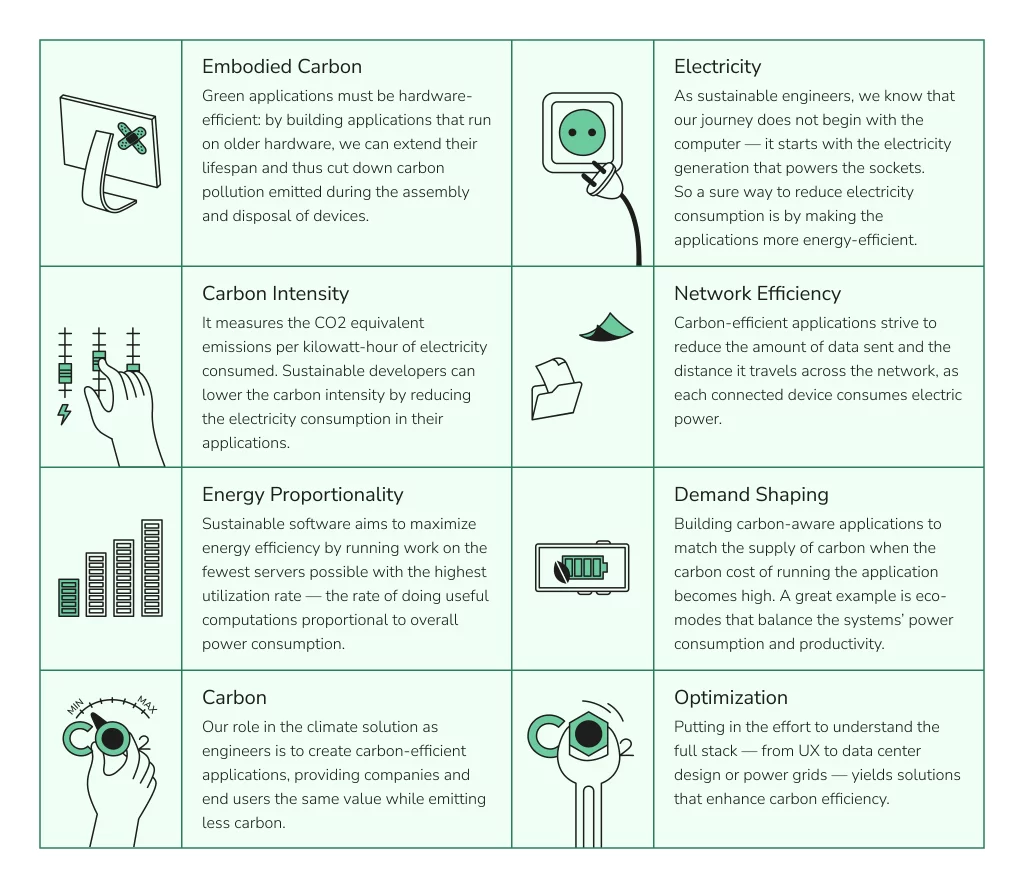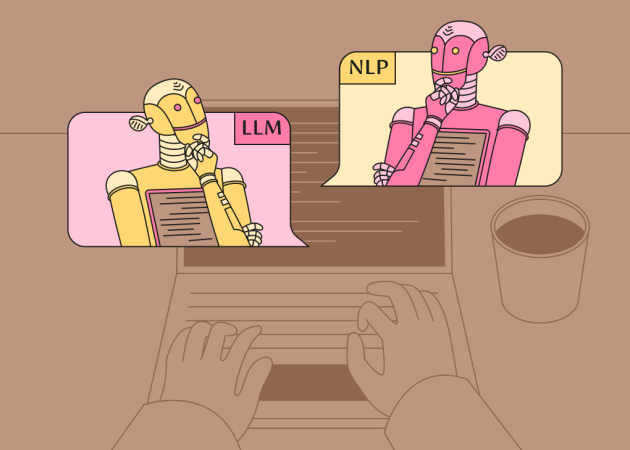
Best Practices of Sustainable Software Development
Contents
Contents
In our previous articles, we explored the use of technology for sustainable development and how it propels the advancement of GreenTech. However, there’s another side to consider — the environmental impact of digital technologies themselves.
The significance of sustainable software practices is set to increase. According to Deloitte, global data center electricity consumption is projected to roughly double by 2030, reaching approximately 1,065 terawatt-hours, driven by the growing demands of artificial intelligence and data processing. Additionally, the Information and Communication Technology (ICT) sector’s greenhouse gas emissions are comparable to those of the aviation industry, as stated in a recent report by the World Bank.
In this context, the concept of “green coding” is gaining traction. Therefore, in this article, we’ll explore the principles of sustainable programming and green software development and how they can be applied to build next-generation digital products that benefit both us and our ecosystems.
Understanding the environmental impact of computing
With data centers consuming a staggering 2% of the world’s electricity and the ICT sector potentially responsible for 14% of the global carbon footprint by 2040, it’s evident that sustainability in tech is a pressing issue that needs to be addressed. Moreover, the IT industry is associated with excessive resource use. Producing electronics like smartphones and computers demands metals and plastics commonly extracted under hazardous mining conditions. The disposal of electronic equipment causes massive environmental harm due to improper recycling practices, calling for responsible processing of old devices.
Sustainable programming in application development is a key area where changes begin. By adopting efficient techniques, using renewable energy, and staying mindful of the environmental effects of programming, we can reduce the environmental impact of the IT industry.
Understanding green coding’s role in reducing energy and emissions involves looking at software’s energy consumption:
- Infrastructure: IT infrastructure, including hardware and networks, needs energy to operate. Often, complex or excessive infrastructure leads to wasteful energy use.
- Processing: The complexity and size of software directly affect its energy consumption during operation.
- DevOps: The coding process involves writing and processing code, requiring energy. If this energy isn’t from renewable sources, it produces carbon emissions. More extensive coding translates to higher energy use and emissions.
A study examining the energy efficiency of 27 popular programming languages found significant differences in energy consumption and execution time. The C language emerged as the fastest and most energy-efficient overall. Compiled languages, as expected, were generally quicker and more energy-efficient, consuming an average of 120J for executing solutions. In contrast, the virtual machine and interpreted languages used 576J and 2365J, respectively. The top five languages in terms of energy and time efficiency were C, Rust, C++, Ada, and Java. At the same time, the least efficient were interpreted languages like Perl, Python, Ruby, JRuby, and Lua (for energy), and Lua, Python, Perl, Ruby, and TimeScript for execution time.
That leads to a dilemma for software engineers who must choose a programming language based on various requirements. The study suggests that if the primary concerns are execution time and energy usage, finding the best language is often straightforward. However, when memory usage enters the equation, the decision becomes more complex, requiring a careful balance between different factors.
What is green coding?
The terms “green coding” and “green programming” are often used interchangeably, but their nuanced meanings may vary based on context:
- Green coding typically refers to the practice of efficient code in terms of resource usage, such as memory and processor time. The goal is to create software that requires less energy to run, reducing the environmental impact of computing. Sustainable practices examples include optimizing algorithms, reducing code complexity, and minimizing the use of resources.
- Green programming is a broader term that encompasses the efficient use of resources in coding and other aspects of sustainable software development, including considerations of all stages of the software lifecycle (from design to disposal) and factors like the energy efficiency of data centers where software runs, the carbon footprint of software development processes, and the recyclability of hardware used in programming.
While both terms focus on sustainability and environmental impact in software development, “green programming” can be seen as a more holistic approach that considers a broader range of ecological factors beyond just the efficiency of the code itself. Green coding aims to strike a balance between programming quality and energy usage.
The main points of green coding revolve around its three foundational pillars, each addressing a different aspect of coding for a greener environment:
Greener logic. This pillar focuses on the efficiency and environmental impact of the code itself. Key considerations include:
- Zero waste code: Writing code that doesn’t waste resources.
- Frequency of use: Considering how often code is executed.
- Proximity: The location relevance of the code.
- Low footprint resources: Using resources that have a minimal environmental impact.
- Benefit-driven visual content: Ensuring visual elements are environmentally conscious.
Greener methodology. It involves adopting lean and agile methods in software development to enhance green coding practices. It also emphasizes the importance of continuous integration and delivery in making the development lifecycle more efficient, thereby contributing to sustainable programming.
Greener platform. This pillar relates to applying green coding principles to the development platform for maximum energy efficiency. It includes:
- Optimal utilization: Avoiding overestimation during planning and compressing code effectively.
- Precise configuration: Tailoring the setup to meet specific green coding goals.
- Holistic metrics: Using comprehensive measurements to assess and improve environmental impact.
Overall, these three pillars guide developers in creating more environmentally friendly code, ultimately contributing to a reduced carbon footprint and a more sustainable approach to software development.
Implementing green coding
Green coding is not just a set of technical strategies; it combines smart tech solutions with an impact-oriented work culture that calls for a fundamental shift in an organization’s approach to IT sustainability.
From a technology standpoint, green coding involves optimizing resource utilization by adopting energy-efficient coding practices. It includes programming that enhances the energy efficiency of multi-core processors and incorporates green IT practices, such as virtualization and containerization, to reduce the number of physical servers. Additionally, it involves breaking down complex software into smaller microservices for better efficiency and optimizing cloud infrastructures to minimize energy consumption.
At the same time, green coding requires a cultural shift throughout the organization. It’s about getting everyone on board with green initiatives, from top-level management to every team member. It means encouraging teams, especially those in DevOps, to think creatively and strategically. And it’s about staying focused on the sustainability goals, even amidst economic challenges and uncertainty.
What is sustainable software development?
Adopting a sustainable approach to software design involves considering and minimizing the environmental effects of software development at all its lifecycle stages. How? For example, optimizing code to reduce energy consumption, using more efficient hardware, and opting for energy-efficient data centers.
In addition to taking an environmentally conscious approach, sustainable software development offers tangible benefits to the customer. For instance, less downtime and quicker updates, as core-level changes to sustainable software can be implemented faster, leading to better overall performance and lower application ownership costs. As a result, companies can react to shifting consumer and market demands more quickly, increasing their agility and competitive edge.
What are sustainable use practices?
The green software framework can be divided into several impact areas. Some examples of sustainability practices in software development are listed below.
| Priority area | Sustainable software practices |
| Software development lifecycle | Carbon-efficient software results from multiple factors — from selecting energy-efficient programming languages and platforms to “green” architecture design and DevOps. For example, interpreted languages consume 48x times more energy than compiled ones. |
| UI/UX | Practice of developing a user-friendly digital experience with efficient accessibility and performance optimization (e.g., easier navigation, modifying UI to support dark mode, compressing content and images). |
| Artificial intelligence | With a responsible target accuracy of the AI/ML models (e.g., repurposing existing models for other tasks), their carbon efficiency can be cut by up to 80%. |
| Cloud and data | Cloud migrations, application development on the cloud for hardware and energy efficiency, and implementation of edge computing can further save project emissions. Efficient data processing involves eliminating storage waste, data compression, improving the utilization of networks, data transmission, workload management, and more. |
| Distributed ledger technology | Energy-efficient DLT algorithms and blockchain technology can positively impact emissions (consensus algorithm, compression strategy, increased transaction frequency, and network design are some examples). |
| IT infrastructure | Driving responsible procurement and end-of-life management of end-user devices, network components, and data center equipment by considering usage and lifecycle emissions and managing electronic waste to ensure green computing. |

Following the principles of green computing
Green computing, or green software engineering, is an emerging discipline that synthesizes the knowledge of climate science, software design, electricity markets, hardware, and data center design. In a nutshell, the principles of green programming form a set of essential skills needed to create and maintain environmentally-friendly software. They apply to all industries, domains, organizations, programming languages, and frameworks. By mastering them, green software engineers can reduce the carbon footprint of their applications.

Benefits of green coding for business
Adopting green coding practices can benefit businesses in many ways beyond just energy efficiency. Companies can demonstrate environmental responsibility while enjoying cost savings, corporate responsibility, market appeal, profitability, and improved operational efficiency. Here are some of the benefits that green coding practices can bring to businesses:
Cost-efficiency and resource optimization: Companies can reduce energy costs by reducing energy consumption. This approach supports environmental and financial sustainability and is particularly valuable given the volatile nature of energy prices.
Positive impact on Corporate Social Responsibility (CSR): Green coding helps businesses accelerate progress toward sustainability goals, such as net-zero emissions, thus enhancing a company’s CSR profile and proving its commitment to ecological responsibility.
Attracting eco-conscious clients and partners: Implementing green coding practices can improve a company’s appeal to environmentally-conscious clients and partners. As sustainability in software and general eco-friendly practices becomes a priority for more businesses and consumers, companies that adopt green practices are likely to find favor with like-minded organizations and individuals.
Improved bottom line: According to the IBM 2022 CEO Study, CEOs implementing sustainability in software and digital transformation initiatives report higher average operating margins. As part of these initiatives, green coding can contribute to financial success.
Better development discipline: Sustainable programming encourages developers to simplify and streamline complex infrastructures, leading to time savings and increased efficiency in software development.
Building a sustainable product roadmap
Consider the following factors to develop a comprehensive and environmentally friendly roadmap; we recommend using them as a framework for your team to make coordinated decisions during all product lifecycle stages.
- Environmental impact. At this stage, remember to pay attention to emission reduction compared to other approaches, incorporating energy-efficient strategies in product development, using materials or their alternatives with sustainable sources of origin, implementing sustainable strategies in supply chains, and refining the “green” aspect of your processes over time.
- Stakeholders. Engaging stakeholders is vital for sustainable development, as it helps owners maximize positive impact by meeting the expectations of all interest groups, including investors, team members, and end-users.
“It is important to carefully research and understand your target audience’s needs and preferences and to design the app with those users in mind. It may involve conducting user research, gathering feedback, and iterating on the design to ensure that the app is
intuitive and easy to use. Also, consider the technical requirements, including the necessary hardware and software platforms, and any regulatory or compliance issues you may need to address.”
Ivan Litovchenko, Tech Lead at Beetroot Delivery Cluster
- Sustainability strategies. Regular team meetings are a great way to keep the team informed on the end goals and to integrate sustainability into the development process. You can also use sustainability reports and drive close cooperation with partners, suppliers, and third parties to exchange and enhance sustainable practices and strategies.
- Measuring success. Last but not least, create specific and measurable goals in your roadmap, including realistic timelines. Be prepared to adjust, reset, and reevaluate these goals to keep better control of deliverables and stay agile to ensure sustainability success.
Engaging like-minded tech partners
As the GreenTech sector expands by leaps and bounds, companies seek to secure strategic partnerships to overcome talent gaps and scaling hurdles. Here are some key points to keep in mind when selecting a technology partner to support your growth.
Collaboration model and scalability
Remote augmentation, or team extension (Dedicated Team), is a favored collaboration model for expanding teams. In this case, software development agencies hire a specific number of remote developers who will become a natural extension of your in-house team while working in your tech partner’s office and under their administrative wing. Likely, they will offer even more flexible team options should you want to test the waters before committing long-term or need a faster tech solution.
Relevant domain expertise
Evaluating their developer standards, tech expertise, and cross-domain competencies is critical when shortlisting candidates. It is best to establish the scope of their experience early in the discovery process. Aside from mining customer reviews, it’s also worth browsing through their social media — the profiles of the company’s executives and key employees.
Approach towards sustainability
Great minds think alike, and great impactful companies should work together. When selecting a company, consider its mission and sustainability efforts as essential factors: shared values and mission alignment prove to work well for both business and positive impact objectives.
“For GreenTech startups, finding the right tech consulting and development partner is often a matter of survival. Consulting services, team offerings, pricing, transparency, and other factors need to be considered during the shortlisting process. Beetroot builds sustainable teams and greentech solutions that positively impact your business and the world.”
Natalia Piantkovska, Business Analyst at Beetroot Delivery Cluster
Driven by a mission to create sustainable social, economic, and environmental impact at scale, we understand GreenTech companies like no other. Just drop us a line — and let’s find a scaling formula that is right for you and your project.
Subscribe to blog updates
Get the best new articles in your inbox. Get the lastest content first.
Recent articles from our magazine
Contact Us
Find out how we can help extend your tech team for sustainable growth.







